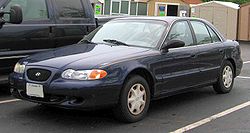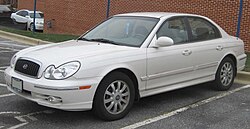The Hyundai Sonata is a mid-size sedan manufactured and marketed globally by Hyundai Motor Company since its introduction with model year 1988. The Sonata has evolved through four generations and several intermediate restylings.
The name Sonata derives from the musical term for a composition featuring one or more solo instruments.
 | |
| Manufacturer | Hyundai Motor Company |
|---|---|
| Also called | Sonata Embera (India) Hyundai Sonica (Italy) |
| Production | 1988-present |
| Predecessor | Hyundai Stellar |
| Class | Mid-size |
| Body style(s) | 4-door sedan |
| Layout | FF layout |
First generation (1988–1993)
 | |
| Production start | 1988 |
|---|---|
| Production end | 1994 |
| Assembly | Bromont, Quebec Canada Asan, Korea |
| Engine(s) | 2.0 L (110 hp) Sirius I4 2.4 L (131 hp) Sirius I4 3.0 L V6 Mitsubishi 6G72 |
| Transmission(s) | 4-speed automatic 5-speed manual |
| Wheelbase | 104.3 in (2649 mm) |
| Length | 184.3 in (4681 mm) |
| Width | 68.9 in (1750 mm) |
| Height | 55.4 in (1407 mm) |
| Designer | Giorgetto Giugiaro |
The first-generation Sonata (Y2) was part of Hyundai's expansion in North America after the success of the Excel. (The original Sonata (Y1) debuted in South Korea in November 1985 with an 2.0 engine on the body of Stellar, which was not successful and is almost forgotten.) It was introduced in South Korea on June 1, 1987. It was then introduced in Canada in September 1987 as a 1988 model, and in 1988, as a 1989 model in the United States. The exterior was designed by Giorgetto Giugiaro of ItalDesign. The vehicle received a mid-term facelift in 1992. It replaced the Stellar as Hyundai's large family car. Sonatas were built in Asan, Korea, and in Bromont, Quebec.
The Sonata was designed by Hyundai and featured Mitsubishi's engineering, including its 2.4 L 110 hp (82 kW) Sirius I4 engine as used in American-market models. A 3.0 L V6 based on the Mitsubishi 6G72 arrived in 1990. The U.S. model received the 2.0 L engine for the 1992, replacing the original 2.4 L engine.
Trim levels in the US were:
- GL (2.4 and 2.0 engines)
- GLS (3.0 engine)
Second generation (1993–1997)
 | |
| Also called | Sonata 2 (S. Korea) |
|---|---|
| Production start | 1995 |
| Production end | 1996 |
| Assembly | Asan, Korea |
| Engine(s) | 2.0 L 126 hp (94 kW) Sirius I4 3.0 L 142 hp (106 kW) Mitsubishi V6 |
| Transmission(s) | 4-speed automatic 5-speed manual |
| Wheelbase | 106.3 in (2700 mm) |
| Length | 185.0 in (4699 mm) |
| Width | 69.7 in (1770 mm) |
| Height | 55.3 in (1405 mm) |
 | |
| Also called | Sonata 3 (S. Korea) |
|---|---|
| Production start | 1997 |
| Production end | 1998 |
| Assembly | Asan, Korea |
| Engine(s) | 2.0 L 126 hp (94 kW) Sirius I4 3.0 L 142 hp (106 kW) Mitsubishi V6 |
| Transmission(s) | 4-speed automatic 5-speed manual |
| Wheelbase | 106.3 in (2700 mm) |
| Length | 185.0 in (4699 mm) |
| Width | 69.7 in (1770 mm) |
| Height | 55.3 in (1405 mm) |
The second-generation Sonata (Y3) debuted in 1993, as a 1995 model. The base engine in most markets was a 2.0 L 126 hp (94 kW) Sirius I4, but there was a 3.0 L, 142 hp (106 kW) Mitsubishi V6 option in some markets. This generation continued after the demise of the Bromont, Quebec plant in September 1993. After that, all Sonatas would be built in Korea, until the opening of the Beijing Hyundai plant in December 2002.
A facelift for the Sonata (Y3 facelift) in 1996 saw modifications front and rear. Sales were up 25% that first year. The four-cylinder engine was up to 137 hp (102 kW) that year as well.
Third generation (1998–2005)
 | |
| Also called | EF Sonata (S. Korea) |
|---|---|
| Production start | 1999 |
| Production end | 2001 |
| Assembly | Asan, Korea |
| Engine(s) | 2.4 L 138 hp (103 kW) DOHC Sirius I4 2.5 L 170 hp (127 kW) Hyundai Delta V6 |
| Transmission(s) | 4-speed automatic 5-speed manual |
| Wheelbase | 106.3 in (2700 mm) |
| Length | 185.4 in (4709 mm) |
| Width | 71.6 in (1819 mm) |
| Height | 55.5 in (1410 mm) |
| Related | Hyundai Santa Fe Kia Optima/Magentis |
 | |
| Also called | New EF Sonata (S. Korea) |
|---|---|
| Production start | 2002 |
| Production end | 2005 |
| Assembly | Asan, Korea Beijing, China Taganrog, Russia |
| Engine(s) | 2.4 L 149 hp (111 kW) DOHC Sirius I4 2.7 L 173 hp (129 kW) Hyundai Delta V6 |
| Transmission(s) | 4-speed automatic 5-speed manual |
| Wheelbase | 106.3 in (2700 mm) |
| Length | 186.9 in (4747 mm) |
| Width | 71.7 in (1821 mm) |
| Height | 56.0 in (1422 mm) |
| Related | Hyundai Santa Fe Kia Optima/Magentis |
A new model arrived in 1998 (1999 for North America), launching the (EF) series.
Engines were 2.4 L 138 hp (103 kW) Hyundai Sirius and a 2.5 L 170 hp (127 kW) Hyundai Delta V6 A special 10-year warranty.
The 2002 model featured the all-aluminum, DOHC 2.7 L Hyundai Delta V6 powered the Sonata with 173 hp (129 kW). It also featured the same Sirius II 4 cylinder which at the time made 138 hp (111 kW), 157 ft·lbf (213 N·m) of torque. Sales reached 104,000 for 2004.
The Kia Optima (called the Magentis in Canada and Europe) was based on the same automobile platform of this generation of Sonata and shared the same doors and some others panels.
This Sonata also lent its platform to the first-generation Hyundai Santa Fe, a compact crossover SUV.
This generation of Sonata is still being built (since 2002) and sold in China as of September 2006 by Beijing Hyundai Co. and in Russia by TagAZ.
Fourth generation (2006–present)
 | |
| Also called | Hyundai NF御翔 (NF Yuxiang) (China) Hyundai NF (Russia) Hyundai Sonata CVVT-i (Malaysia) Hyundai i40 (Europe; 2008-) Hyundai Sonata Transform (KDM Facelift) Hyundai Sonata Embera (India) Hyundai Sonica (Italy) |
|---|---|
| Production start | 2006 |
| Production end | Present |
| Assembly | Montgomery, Alabama Asan, Korea |
| Engine(s) | 2.4 L, 163-175 hp (32.5 kW), I4 3.3 L 237-249 hp V6 2.0 CRDi ( European & Australasian Market only) |
| Transmission(s) | 4-speed automatic 5-speed manual 5-speed automatic |
| Wheelbase | 107.4 in (2728 mm) |
| Length | 188.9 in (4798 mm) |
| Width | 72.1 in (1831 mm) |
| Height | 58.0 in (1473 mm) |
| Related | Hyundai Santa Fe Hyundai Grandeur/Azera Kia Optima/Magentis/Lotze Kia Carens/Rondo |
The 4th generation Sonata was launched in August 2004 in Korea, based on a new platform created from the project NF costing of 290 billion won. The company's first all-aluminum I4 engine, dubbed Theta, debuted in the new Sonata. Engine choices at launch were a 2.4 L I4 that produced 164 hp (122 kW) at 5,800 rpm and a 3.3 L 237 hp (177 kW) V6. The diesel version was used as a taxicab in Singapore.
The U.S. May 2005 launch of the new Sonata coincided with the production commencement at the company's first U.S. assembly plant — in Montgomery, Alabama.
Classified by the U.S. Environmental Protection Agency as a large car, the fourth generation was 2 in (50.8 mm) longer and taller and 1 in (25.4 mm) wider than the previous generation. Standard features included anti-lock braking system/electronic stability control/traction control system as well as six airbags (driver/front passenger front and side, and side curtain).
The National Highway Traffic Safety Administration (NHTSA) awarded the Sonata with 5 Stars in frontal and side crashes.[2] The Sonata received a "Good" offset frontal impact rating, an "Acceptable" side impact rating, and a "Good" rear crash protection rating from the IIHS.
Facelift
Hyundai facelifted the Sonata for the 2008 model year, marketing the revised model as the Hyundai Sonata Transform in Korea, and debuting the model elsewhere as an 'early' 2009 model. While the original 2006 fourth generation model was designed primarily in Korea, the restyling was designed primarily at HATCI (Hyundai-Kia America Technical Center, Inc) in Superior Township, MI — its first major assignment.
The redesign features revised engines, front fascia and grill, taillights, headlights, wheel cover designs and an extensively revised IP (Instrument Panel). Hyundai adopted the "slush molding,” production technique that enables much a much higher grade of texturing and shaping of the IP surface.
Redesigned gauges feature a blue backlight, and a touch-screen navigation system, optional on the 'Limited' trim level only, includes satellite radio capability. Bluetooth capability is available as an optional unit, separate from the audio or navigation system, and all models include both a USB port along with an auxiliary input jack. An optional USB adaptor cord allows integration of an iPod, and chrome interior door handles are standard on the Limited trim.
The 2.4L Theta II engine receives an eight-percent increase in power to 175hp (168 hp with PZEV) and the 3.3L Lambda V6 receives an increase from 234 to 249 hp (186 kW). Fuel efficiency is EPA rated at 22/32 for the I4 and 19/29 for the V6. The base model GLS is available with a manual five speed transmission. GLS, SE and Limited models feature a newly available, manually-shiftable five-speed automatic transmission marketed as "Shiftronic."




No comments:
Post a Comment